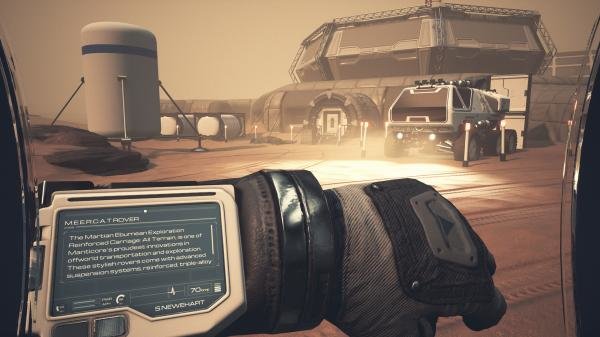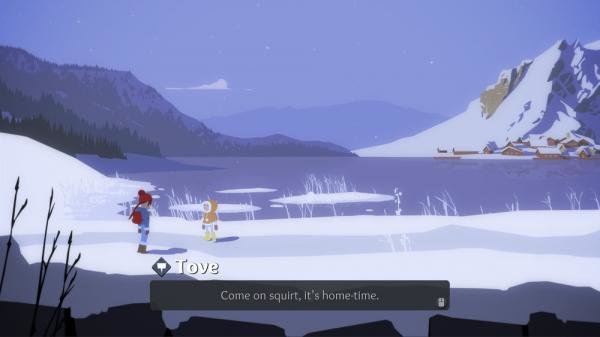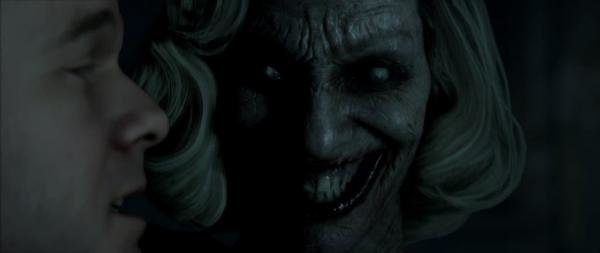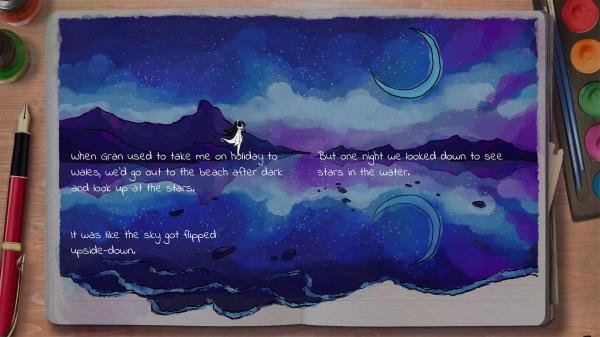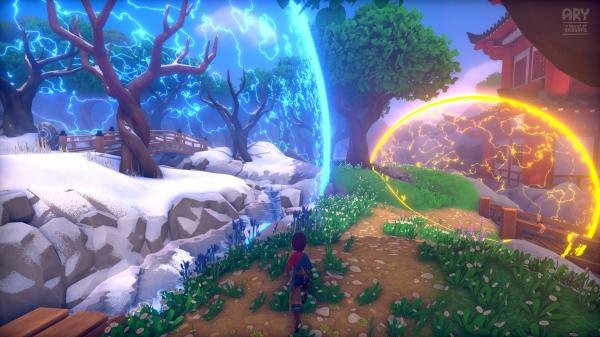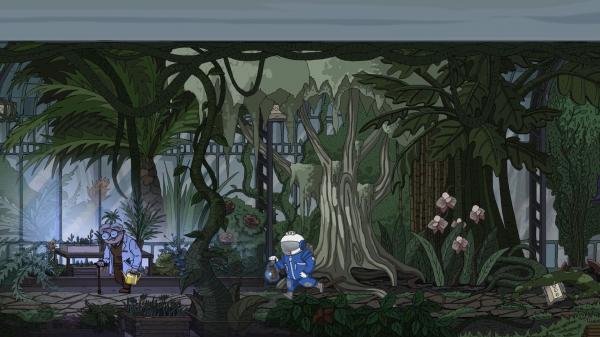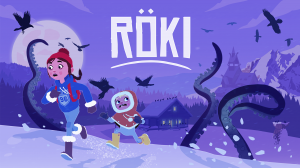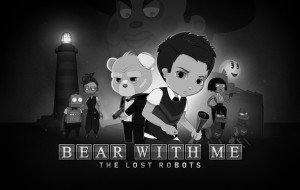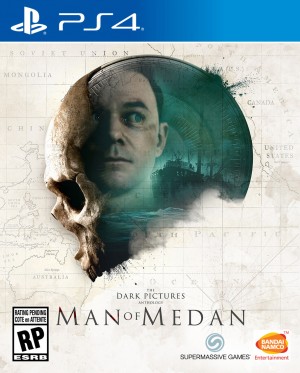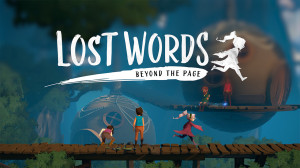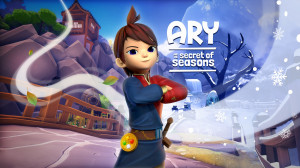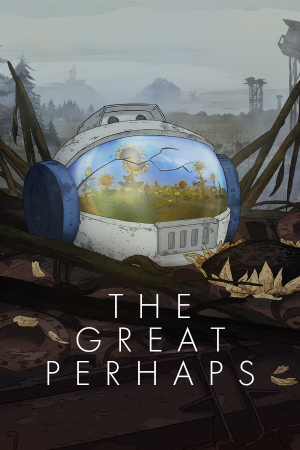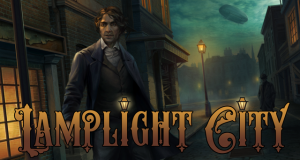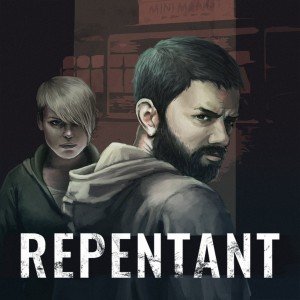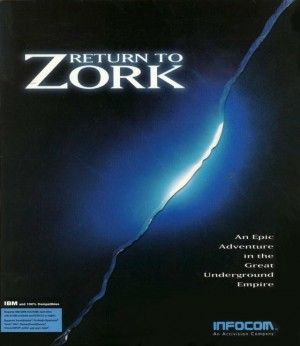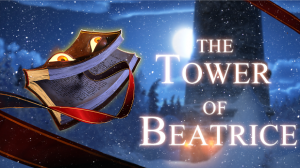E3 2019 round-up page 2
Events Coverage
Reporting from E3, GDC, AdventureX, Gamescom and other gaming events around the world

The E3 games convention in Los Angeles may be in the books for another year, but Adventure Gamers didn't sit idly and let it pass right by. This year, between fighting my way through the crowds I got lost between the pages of a young girl's diary, visited Mars and ghost ships, uncovered the secrets behind seasons and suicides, and helped out a time-traveling astronaut. All in a day's work (or rather, three days' work) for a firsthand glimpse at the promising new games heading our way in the coming months.
Moons of Madness
The term “cosmic horror” was long ago coined by H.P. Lovecraft to refer to otherworldly terror beyond time, space, or sanity. The developers at Rock Pocket have taken the term to a whole new level and created something truly special for horror fans in Moons of Madness – “Cthulhu in Space”, if you will. When I asked Eirik Leganger Nergård, PR manager for publisher Funcom, to assure me that this game wasn’t just going to tease the scares without delivering, he smiled knowingly and told me he didn’t think I would be disappointed. How right he was.
The Invictus space station is home during your stay on Mars. Although you’re not the only soul on board, don’t expect to get much in the way of personal interaction or back-up from other crew members. In other words, any feeling of “safety” in numbers is a luxury you rarely have as the game progresses.
Trouble doesn’t take long to get going, either. As the protagonist Shane, something awakens you in your bunk, but nobody else seems to be around. Upon leaving the station’s crew quarters, you can just barely make out what seems to be a humanoid shape disappearing from view across the room. The game’s opening sequence immediately puts you in an uncomfortable state of mind: it’s dark, things aren’t working the way they should, and odd and disturbing visions occur all too often.
After playing through this opening equivalent of jumping headfirst into the freezing-cold deep end of the pool, Shane finally wakes up for real; perhaps it was all just a dream. The rest of the demo had a more nerve-tingling, slow-burn feel to it. Players are able to explore the Invictus at their own pace, with no penalty for playing slowly and exploring every nook and cranny. The designers have taken their time to incorporate plenty of environmental storytelling into the surroundings, from learning about Shane’s romantic conquests the night before, to perusing the crew’s personal emails from various computer terminals around the station. Eirik estimates at least eight hours of gameplay, and even more for leisurely explorers like myself.
The sense of loneliness continues, despite the radio communication with Shane’s friend and crewmate Orson. Orson gives Shane his first few travel destinations, as the game guides you along under the guise of malfunctioning door systems that only get unlocked little by little. In this way, you are introduced to the living quarters and kitchen, the gym and some picturesque views of Mars. Eventually you’ll retrieve your biogage, an arm-mounted personal scanner that also doubles as an inventory screen and objective display. There are various types of puzzles to solve, including searching the environment for computer access passwords and using inventory items to reset the biogage or force open a door that’s gotten stuck. Everything plays out from a first-person viewpoint.
Ah, but as fascinating a setting as a Mars station can be, Moons of Madness isn’t a game purely about exploration. Sooner or later the creepy factor settles back in, and I was thrilled when entering the greenhouse area as a foreboding mist began spreading and I was tasked with jumping into a darkened vent shaft in order to bypass some locked security doors. Sadly, there wasn’t much of the demo left at that point, but before my time was up I was treated to a menacing cliffhanger that dispelled any expectation of this being a tame walk in the park. I was told there won’t be any outright action sections in the final game, but there will be moments of having to defend yourself or run for your life – the dangers are very real and very angry.
Moons of Madness showed me some glimpses of everything I want in a game: a fascinating setting that tells its hidden story for those willing to look deeply into it, mixed with the unsettling tension and horrifying reveals that Lovecraftian fiction is well known for. Best of all, PC, PlayStation 4 and Xbox One players should only have to wait until Halloween to play the finished product.
Röki
For a change of pace, I sat down with Tom and Alex from UK-based developer Polygon Treehouse to take a look at their lovely fairy tale-esque homage to point-and-click adventures. Röki is a game intended to work for seasoned genre veterans as well as younger players, so really it is aimed at the whole family. It’s heavily inspired by Scandinavian folklore, which is immediately evident in its namesake antagonist, the large furry behemoth Röki. I didn’t get to see any of the lumbering giant, unfortunately, as my gameplay demo focused more on the everyday heroine, Tove.
The older sister of Lars is described as a bookworm and reluctant adventurer. The children’s family has gone through some hard times, and Tove has taken it upon herself to watch out for her younger brother. It’s all the more shocking then when Lars is taken by Röki, for reasons unknown. Tove now sets out on a fantastical quest to track down the giant monster and return her sibling home.
Polygon Treehouse chose to create Tove as a protector yet still a child herself because of the innate power to see the world without prejudices and preconceived notions that children are capable of. As such, Tom and Alex were hesitant to call Röki a villain, but rather hinted at the possibility that sometimes creatures’ motives can be misunderstood, and that Tove’s journey would shed further light on the story than is at first apparent.
Armed with this knowledge, I set out on my quest through a quiet stretch of woods. Players handle Tove’s movement directly with the controller, while an on-screen cursor can be moved to drag objects from the inventory pane to interact with others in the environment. Puzzles in the game come in several varieties, some inventory-based but also others that require careful exploration and manipulation of your surroundings.
Picking up my first couple of objects, I came across two possible roadblocks to overcome. A locked gate barred the way to a large church beyond, while elsewhere a bridge troll begged my assistance with a pesky dagger stuck in his back that was bothering him. I was starting to draw parallels to other games: the bridge troll, the fairy tale forest – the classic King’s Quest vibes became hard to ignore.
Then a third interesting location, a house buried up to its eaves in snow, beckoned me to explore it via a hole in its exposed roof to collect another useful item. I now had enough objects to make some headway in solving a puzzle or two, and a click of the left control stick to highlight all hotspots on the screen confirmed that I hadn’t missed any of them. Although the puzzles I saw had some fairly straightforward solutions rather than requiring multiple convoluted steps, they weren’t easy to the point of being immediately evident, and fooling around with objects in various ways was a joy in and of itself.
The team expressed their pleasure at letting players figure out what works and what doesn’t, and the serene hand-drawn forest setting combined with a relaxing, atmospheric ambiance honestly put me in no rush whatsoever to get there. In fact, for those who want to delve a bit deeper and spend a bit longer within the game’s world, collectible items are scattered throughout and Wilderness Scout Badges can be earned by performing certain non-vital tasks, while an in-game journal fills with some colorful lore as you discover new things.
While all of that sounded like music to my ears (in addition to the game’s literal music soothing my senses), when both the bridge troll and the church gate had been bypassed, the way forward opened, my time with Röki was coming to an end. The full estimated eight-hour experience still isn’t quite ready, and the team isn’t yet prepared to announce final release dates and platform availability, but if my short time with this bit of Scandinavian folk tale is anything to go by, this is one to keep an eye out for.
Bear with Me: The Lost Robots
Developer Exordium Games is heading back to the well with Bear With Me: The Lost Robots, a prequel episode to the already-completed three-parter that released in 2017. Fans of the established series will feel right at home, as the new installment features the same black-and-white 1940s noir approach and the same wise-cracking stuffed animal protagonist.
Yes, Ted E. Bear is back and still the diminutive hard-boiled detective type he always was (or rather, will go on to become). Rather than his normal partner Amber, this prequel sees Ted team up with Amber’s younger brother Flint to take on the case of the city’s mysterious robot disappearances.
The game is still very much a classic point-and-click detective story, complete with alcohol, fedora and comic book panel narration scenes to move the story forward. In the short time available for the show floor demo, I started off the investigation by getting locked in a theater projectionist’s booth, using the items available to make a daring escape and head down to street level where I discovered that the robotic ticket seller had been abducted. The only clue left: a handful of nuts and bolts left at the scene of the crime, precious little to provide any leads. But we know that grizzled gumshoes like Ted have come through with less to go on.
Where the story will go from here is anybody’s guess, but it’s already evident that it possesses a similar type of cheeky humor as its predecessors. For those who haven’t already solved Ted and Amber’s case, all four episodes will be available in one collection when The Lost Robots releases on July 31st, but for those who have, the episode will also be available for purchase individually as a standalone game.
Mosaic
One could easily make the mistake, as I did at first, of thinking that Mosaic is a dull gaming experience. Except it’s not really a mistake at all, or not entirely. The new title from the creators of Among the Sleep is designed in such a way as to drive home the point that its protagonist, Inge Nilsen, is a slave to the system of work-eat-sleep-work, living an unfulfilling life devoid of all color and variety. Understandably, the game looks suitably gray and drab. Krillbite Studio even produced a real-life companion app called BlipBlop for iOS and Android devices – the same mindless game Inge plays, spent just tapping the screen – as well as grayscale business cards of Inge’s to hand out during the E3 demo sessions. Nothing around Inge inspires any sort of true happiness…
That is, until leaving Inge’s apartment for work one day, you decide to turn left down the hallway instead of right toward the elevator. There a window, never before noticed, offers a view of the outside world in which glorious colors suddenly fill Inge’s field of view. One can practically feel the sigh of peaceful relief going through Inge, the wheels of imagination beginning to turn, a horizon of boundless possibilities.
But then reality crashes back down: work is calling, so it’s back down the gray hallway to the gray elevator to take Inge to another gray day as Assistant Resource Technician at Mosaic. There will surely be more to Inge’s life than this later on, so those interested in seeing whether he is able to break free of the drone life can do so when the game releases this fall on PC and all major consoles.
The Dark Pictures: Man of Medan
I’ve been a pretty big fan of some of Supermassive Games’ efforts in the last four years, starting with Until Dawn, so at E3 I jumped at the chance to go hands-on with their upcoming Man of Medan, the first entry in the Dark Pictures interactive horror anthology series.
Each standalone release in the series promises to explore different horror themes, and the section I sampled focused on the “home invasion” trope, though played out a little differently than usual. The game’s cast of five twenty-somethings – loving couple Alex and Julia, Julia’s brother (and self-professed ladies’ man) Conrad, Alex’s younger brother Brad, and Fliss, the captain of the chartered Duke of Milan – are out for a pleasure cruise in open waters when their boat is overtaken by modern-day pirates one evening as a fierce storm approaches. Though the pirates won’t say what it is they’re after, they’re clearly searching for something and not above exacting some violence on their hapless hostages to get it. A bruised eye, a severed ear and more may be in store depending on how you play your cards.
Neither the gameplay nor the graphics are really all that different from the studio’s recent offerings – we’re still in the same console generation, after all, though this will be the first Supermassive game to be launched on PC as well – but considering how photorealistic character models have looked in their past games, that’s not a bad thing. Water effects are a mixed bag at this stage, with extremely impressive rainfall from the onsetting storm running down window panes, while the agitated ocean waves tossing the boat back and forth are less so.
Much of what you as the player do is still relegated to watching the drama play out in cinematic fashion, interspersed with frequent timed decisions and Quick Time Events. Want to mouth off and put up a front to the pirate leader, or meekly comply with his demands? Given the choice of untying one of your fellow prisoners, who do you go for first? Should Conrad quietly sneak off the boat to safety or go for the unattended knife and attempt a heroic rescue on his own? It’s all up to you, and the characters’ relationships with each other, their personal traits, and something the game referred to as “bearing” are constantly changing as a result of your choices (or lack thereof), with on-screen messages to remind you that there are consequences.
Though the game eventually leads to an even more disturbing new set piece – the Duke of Milan eventually runs afoul of an abandoned ghost ship – the demo ended before I got the chance to board it. While all five of my characters made it through more or less intact, it’s possible for some of them to die even this early on. This being a Supermassive release, the whole game can be finished with everybody remaining alive, or with the entire cast meeting their demise, along with various combinations in between.
It’s definitely not groundbreaking considering the developer’s previous work, but as a fan of schlocky horror, Man of Medan is right up my alley and I cannot wait to hoist anchor and set sail with the full game when it releases August 30th on PC, PlayStation 4 and Xbox One.
Lost Words: Beyond the Page
Having seen what E3 had to offer this year, I can safely say that Sketchbook Games’ Lost Words: Beyond the Page made the biggest leap in my personal book, going from a game I’d not heard of before to one of my top games of the show in record time. It may not be flashy or bombastic, but it delivers in some key areas that are oh-so-important. It's also one of the very few times a game has been able to make me choke up on the strength of a fifteen-minute game slice alone. Speaking with Mark Backler, the company’s founder, I was able to experience one of the loveliest demos I’ve seen this year.
The gameplay is split into two main sections. Players take on the role of Izzy, a young girl who’s been given a diary by her grandmother and plans to use it to become a better writer. One part of the game is devoted to actually exploring the diary, using it to learn about Izzy and her family, her hopes, dreams, and personality. This is done in a unique style, by actually running and jumping across lines of text as they appear in the diary, with certain purple words causing something to change or appear on the page. It’s wondrous and whimsical, and the writing perfectly captures Izzy’s worries, insecurities and annoyances toward her younger brother.
Then there’s the fantasy land of Estoria, the world that Izzy actually dreams up as she’s writing her diary entries. Here the player similarly controls Izzy’s alter ego as she embarks upon her quest to become the new firefly guardian after her grandmother, the previous guardian, has passed the torch on to her. Since it’s Izzy’s story to write, events in Estoria mirror what happens in Izzy’s real life, and I had a fantastic time reading between the lines, so to speak, as the world of Estoria helped me understand more about Izzy’s personal life.
Both halves of the game feature on-screen text; there's even an excited “Whoooooooo!” as Izzy slides excitedly down a hill. But there’s another, more novel way that words factor into the gameplay. Certain words can be lifted from their surrounding text by using an on-screen cursor (the “firefly”, in Estoria) and used to affect the environment by doing exactly what they say. For example, pulling the word “Rise” out of its scene’s descriptive text or from a book the protagonist carries specifically for this purpose and then dragging it over the ground will cause it to lift up, making high ledges accessible, while dragging the command “Unlock” over a gate will cause it to swing open and reveal the path forward.
As engaging as that is, the true heroes of Lost Words are its musical score and Izzy’s voice actress, which together made it possible for me to become emotionally invested as fully as I did. With an estimated playtime of only about three hours, the soundtrack has to quickly establish the carefree world of the game’s opening to allow later events to become more powerful. Similarly, there’s not much time to connect with Izzy, and actress Sidonie Maria, whom I learned was actually a part of the development team when she recorded what was assumed to simply be temporary voice-over, does a fabulous job being relatable as the young heroine from the very first second, in what may well turn out to be one of my favorite voiced roles in a very long time.
With a story penned by Rhianna Pratchett, players will surely also have a worthwhile narrative to look forward to when the game releases in December on PC and all major consoles. Based on my memorable experience with the demo, I plan to be one of the first in line to play the finished product.
The Suicide of Rachel Foster
The Suicide of Rachel Foster features exploratory gameplay not unlike other titles from the past few years such as Gone Home and Tacoma. This basically means that players spend much of their time scouring the game world from a first-person perspective, occasionally jumping in to resolve a dialog choice or some light inventory-based puzzling, but otherwise generally letting the game tell its story. Daedalic is publishing, and Justus Jeromin was on hand to tell me more as I played through the demo for this mystery adventure developed by 101% Games and Reddoll.
To immediately avoid any misconceptions, players do not take on the role of the titular Rachel Foster. Nicole, a young woman with a troubled family history, has just been informed of her father’s passing and told that she’s inherited the large mountain hotel where she grew up. Against her better judgment, Nicole heads to the now-empty hotel to collect some personal belongings and officially wrap up this transaction when a terrible snowstorm traps her in the vacant building. With no chance of getting away, Nicole begins digging into what skeletons, literal or figurative, may be buried in her family’s past, and soon learns that not all was as it seemed with her late father.
If this story setup sounds at all familiar, then you’re probably thinking along the lines of King/Kubrick’s The Shining. That is no accident, and while Rachel Foster may be less bent on providing murderous scares, it’s hard not to get at least the slightest of shivers from being trapped in a spooky large hotel setting with not a fellow soul in sight. Nicole is in touch with another man via telephone, so there is someone to bounce some dialog off of, but that’s little comfort when the storm is howling outside and you have to head down to the basement.
Early sections of the demo required me to travel to various parts of the hotel, like the grand ballroom and the family’s apartments where Nicole spends some time in her childhood room. Although there is a map of the hotel hanging behind reception, I was pretty impressed by how well I was beginning to get the lay of the land on my own, as the hotel’s logical layout immediately started etching itself into my mind. Realistic graphics, smart level design, and detailed set dressing naturally helped.
I chose to stop playing early, as I dearly want to experience the whole game without too much being spoiled ahead of time, and I already know I’m going to want to move much slower and take in my surroundings at my own pace. While I can’t say for sure what direction the story will take, it seems unlikely that it will just follow tired horror-movie tropes, and who Rachel Foster is and what role she plays in Nicole’s story remains, as yet, a mystery to me. Other fans of environmental storytelling won't have long to wait to find out right along with me, as the game is scheduled to release “soon” on PC, PlayStation 4 and Xbox One.
Adams Ascending
A one-man passion project from Nick DePalo of Parable Worlds, Adams Ascending stars a young boy named Adam, who’s seemingly waiting at a campsite for his father to arrive to spend the weekend grilling hot dogs and telling spooky stories. As Adam begins exploring the surrounding environment, he narrates a few anecdotes of their previous camping trips. After encountering some areas that seemed only half-rendered in the gameworld (something I attributed to an incomplete demo build), I was just starting to wonder where this was going when the game abruptly threw a curveball.
Suddenly the campgrounds around Adam began to disappear and be replaced with metal walls and floors. It turns out Adam was on a spaceship Holodeck the entire time, instantly throwing up dozens of questions in my mind. But there was no time to consider more; the reason the computer had to pull him out was because of a mechanical malfunction that is now causing the entire spacecraft to catch fire.
While running to escape the flames, Adam’s dad contacts him via communication channels, instructing him to get on an escape pod and flee without him. Under protest, Adam has no choice but to comply. The final scene of the demo featured Adam in his shuttle, sobbing, as the vessel behind him bursts into a million pieces. What comes next I have no idea, except that there will be some action elements blended in, but Adams Ascending certainly got my attention in a brief space of time. If you want to check it out for yourselves while waiting for the full game to release sometime in 2020, first on PC before possible console ports to follow, a pre-alpha demo is available to download on Windows and Mac to anyone who signs up to the developer’s newsletter.
Ary and the Secret of Seasons
Created by Belgian developer Exiin Studio, Ary and the Secret of Seasons is an action-adventure game heavily inspired by Nintendo’s Legend of Zelda franchise, both in look and gameplay, but featuring an all-original world to explore. Here something has happened to upset the balance of the four seasons and their Guardians, and young Ary must restore that balance and take the place of her father, the Guardian of Winter.
One of Ary’s major objectives is the destruction of corruptive crystals around the world. To do this she must travel to the four temples of seasons, brave their challenges, and emerge victorious against bosses that carry within them artifacts needed to complete her quest. But she isn’t entirely helpless, either. Ary is able to cast seasonal spheres that bestow certain elemental properties on the area they affect. For example, casting a sphere of summer on a frozen lake creates a globe of warmth that melts the ice in one particular area, letting Ary swim down into the otherwise inaccessible waters.
Combat takes advantage of this ability too, and it is here that the demo kicked in. Exiin’s Alex walked me through the protagonist’s struggle against a large flying bird boss named Frozen Ashes, who casts a perpetual sphere of winter around himself (enemies can take advantage of the same magic Ary possesses to turn the tide back in their favor). In this way, boss battles have a certain puzzle-like quality, requiring a good bit of thought be put into using abilities wisely.
Being a very mobile enemy, this boss covered quite a bit of real estate. As the giant bird flew across the sky, the wintry sphere surrounding it generated icy platforms into being, which Ary could use to keep up, albeit at a necessarily quick pace. Once the bird became somewhat more stationary, it was time to counteract its frigid state with a sphere of spring, which melted some of its icy armor where touched, opening it up for some damage. Various phases of this boss require different strategies to proceed, but a generous checkpoint system ensures never having to start too far back in case of death.
After Frozen Ashes was vanquished and its artifact claimed, the corrupted crystal could be destroyed and the land set one step closer to recovery. While Alex was understandably tight-lipped about much of the game’s story, she did share that Ary will gain more seasonal powers as she completes dungeons and defeats their bosses. Though Ary used a sword to battle in the demo, other weapons will make appearances, such as a slingshot that lets Ary cast her spheres from a distance. All enemies, not just bosses, have certain seasonal strengths and weaknesses, and it’s up to players to figure out the best approach to defeating each one. In the spirit of exploration, gaining new abilities will also enable Ary to reach previously inaccessible locations.
Though I wasn’t able to play the game myself, the third-person controls looked smooth, and the opportunities for creative play using the seasons seemed like an inviting prospect. The development team isn’t announcing a solid release date yet beyond simply sometime early in 2020 when Ary and the Secret of Seasons heads to PC and all major consoles.
The Great Perhaps
Even though Caligari Games’ The Great Perhaps is a narrative puzzle game at heart, it represents a meld between a traditional point-and-click adventure and side-scrolling exploration game. It’s one of those games that front-loads a quick setup, then leaves the player to piece together the whos and whys behind it. The “big thing” has already happened when the game begins, and now it’s up to you to learn more about it. Daedalic’s Jonas Hüsges was on hand to help me do just that.
The game sets up its mystery in an opening cinematic. A Russian astronaut, in orbit aboard a space station, overhears an enigmatic order from his planet-side commanding officer directing the station’s AI to immediately put him into cryosleep. Before it can take effect, the astronaut bears witness to the first few flashes of light coming from Earth, signaling the impending nuclear apocalypse taking place many miles below him. The next thing he knows, he awakes from cryo one hundred years later, looking down from his observation window at a destroyed, radioactive planet.
If that doesn’t sound like a sobering enough premise for a game, then the astronaut’s next decision – to jump into a shuttle and seek out life and any sign of what happened to his loved ones on the planet’s surface – surely is. And so begins what promises to be a very harrowing drama on a post-apocalyptic world.
Earth has been ravaged and made radioactive, but there is life left here, as the astronaut’s readings show – what form this life may have taken on, however, is a different question altogether. Still dressed in his protective space suit, he begins the slow and arduous trek to find survivors. The places he passes tell their own silent story for you to pick up on; here a home abandoned in a hurry, there an arena that many people perhaps once took shelter in. An occasional puzzle requires some light inventory use, though what the astronaut can use is always restricted by what he is able to carry in his hands at the moment, rather than a full-fledged inventory.
An unexpected gameplay twist comes soon after his arrival back on the surface when the astronaut comes across a lamp that lets him look back into the past. When activated, everything in a cone in front of you is shown as it was before the end of the world, including the occasional bodily remains of some unfortunate person or another. This is pretty handy when it comes to puzzle-solving, but the game goes one better: a quick button press activates the lamp, while a long button press actually lets you physically time travel to the past and back again. This is a great way to get around locked doors, for instance, though it’s a power best used away from unsuspecting eyes as people in the past don’t take too kindly to spacemen materializing right in front of their eyes.
It’s not all locked doors and broken machinery, though; sometimes more acute dangers need to be dealt with. Traversing a subway tunnel requires a delicately-timed dance between past and present. In the astronaut’s time, a mutated two-headed rat creature is blocking the tunnel and will wake to give chase if you come too close. Switching to the past, however, will put you squarely into danger of being struck by oncoming trains. Through careful use of the lamp, both obstacles can be avoided, but probably not before suffering at least a few grisly setbacks.
Jonas estimates the finished game should yield approximately six hours of gameplay when The Great Perhaps lands on PC before the end of this year.
Grave Shadows
Grave Shadows is a school project created for, and chosen as a finalist for, the E3 College Game Competition by a team of six students at the Rensselaer Polytechnic Institute. It features former-detective-turned-private-eye Colton Graves, who, while on a job investigating a local crime syndicate, got too close to the truth. Having become a liability, the Family struck back, costing Colton’s partner his life and accidentally granting Colton the ability to meld into shadows. Now Colton is on a quest to figure out who sold him out and get revenge for his partner.
The core gameplay is puzzle-based, having to work out ways to maneuver environments and collect evidence without being detected, using light sources (and the absence thereof) to take advantage of Colton's shadow-meld ability. Presented entirely in a 3D black-and-white noir style, complete with trenchcoat and fedora for the protagonist, the game presently takes about an hour-and-a-half for a single runthrough. Evidence locations and the identity of the traitor are completely randomized from a list of five suspects, and between scenes Colton must take the collected evidence to his pin board to start narrowing down his choices.
The game in its current state is available for free on itch.io, though the team is working on refining and expanding a finished retail version that they hope to have ready for a summer 2020 release on Steam.
Half Past Fate
Speaking to Zhenghua Yang (or “Z” as he introduced himself), the man behind development studio Serenity Forge, I first learned of Half Past Fate, which is essentially an interactive romantic comedy styled as a cross between visual novel and point-and-click adventure. It’s the story of six people who meet in various ways and become involved in relationships with each other. Rather than look at the dramatic side of romance, however, it’s a game that focuses on how people meet and such stories begin.
Half Past Fate has a charming pixel art style with quite a bit of detail bringing the environments to life. The scene I was able to see in the demo featured a character at a coffee shop doing what he could to convince other patrons ahead of him to give up their spots in line so he could impress the cute barista. Little did he know that while he was destined to meet his soulmate that very day, it wouldn’t be the woman he originally had his eyes on.
The game takes a decidedly lighthearted approach to its storytelling, and quite a bit of effort has gone into designing the various locations and characters, to the point that NPCs encountered in one story will pop up in other stories as well – this world is a small one, and everybody knows each other. There are multiple chapters to each story, and the game cycles from one tale to the next and eventually back again in twelve separate chapters.
Final release is planned for Windows PC sometime in 2019, though no particular launch date has yet been set.


